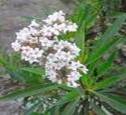| Kingdom | Plantae |
| Order | (unplaced) |
| Family | Boraginaceae |
| Subfamily | Hydrophylloideae |
| Genus | Eriodictyon |
| Species | glutinosum |
| Binomial name | Eriodictyon glutinosum |
Other Common Names:
The other common names for the herb Yerba santa are Mountain Balm, Consumptive's Weed, Gum Bush, Bear's Weed, Holy or Sacred Herb and Tarweed.
History
The Yerba Santa, meaning "Blessed Herb." is a native member of the Waterleaf or Phacelia Family, the Hydrophyllaceae. Yerba Santa, one of the best known of these western plants, still bears the Spanish name given to it by the padres, who learned of its value from the Indians. The Eclectic Medical Journal published an article on the uses of the yerba santa in 1875, while, in 1894, the shrub was listed in the Pharmacopoeia of the United States granting the approval of its therapeutic use.

Description


Range
The yerba santa is indigenous to the California and Oregon regions in the United States and is also found in the northern parts of neighboring Mexico.
Habitat
The plant grows naturally and thrives on arid mountain slopes. The yerba santa normally grows at altitudes of approximately up to 4000 feet or 1200 meters above the sea level.
Cultivation
The plant prefers light sandy soils and requires well-drained soil. The plant prefers acid, neutral and basic alkaline soils. It cannot grow in the shade. It requires dry or moist soil. This species is not hardy in the colder areas of the country; it tolerates temperatures down to about -5°c.It is probably best grown against a sunny wall. If the plant needs pruning to keep it within bounds, then this is best carried out in spring or early summer. Do not cut back to wood more than 2 years old.
Propagation
The seeds are sown in spring in a greenhouse. Prick out the seedlings into individual pots when they are large enough to handle. Grow on the young plants for at least their first winter in a greenhouse and plant out in late spring or early summer. Give some protection from the cold for at least their first couple of winters outdoors.
Flowering Season
The flowers of the yerba santa are in bloom between the months of July to August.
Pests and Diseases
Yerba Santa is affected by aphids and fungal diseases. Wooly blue curls are often found among these plants.
Parts Used

The dried leaves of the plant are the most commonly used part for its medicinal and commercial purposes.
Medicinal Applications

• Yerba santa is used in treating bronchial and laryngeal troubles and chronic pulmonary affections, and also for asthma and hay-fever.
• It is advised for haemorrhoids and chronic catarrh of the bladder.
• The herb is considered to be a precious expectorant and is used to cure ailments like tracheitis, bronchitis and asthma and other respiratory tract disorders.
• Yerba santa is also effective in curing insistent pulmonary infections, hay fever and asthma and is an excellent blood purifier.
• Externally used for treating bruises, sprains and wounds.
• A steam bath made from the branches and leaves has been used in the treatment of rheumatism.
• A decoction of the leaves has been used as a wash for sore areas and painful fatigued limbs.
• The plant has been smoked as a remedy for asthma.
Commercial Applications
• The tea of yerba santa makes an especially good mouthwash.
• The fresh leaves are chewed for their refreshing taste and to relieve thirst.
• An aromatic sweet tea is made from the fresh or dried leaves.
• An extract of the leaves is used as a flavouring in baked goods, sweets, ice cream and soft drinks.
• The leaves have been woven into skirts and aprons.

Yerba Santa, also called HOLY HERB and SACRED HERB by practitioners of curandismo, the Mexican herbal healing and magical arts. The "holy herb," it has a long history of use as an Altar Offering. This is said to bring spiritual aid to the home when a handful of dried yerba santa is placed in an open dish on the altar, mixed with Blessed Thistle, Angelica (Holy Ghost Root), Cascara Sagrada (Sacred Bark),Basil (Sacred Basil), and any other herbs or roots whose names contain the words "holy," "sacred," or "blessed."